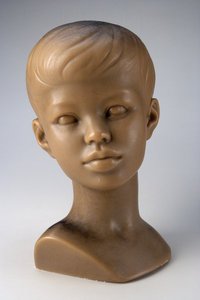xoxoo love, loser
American culture is obsessed with winning and success, yet it is fixated on losers.
On August 10, 2010, in the final episode of Work of Art: The Next Great Artist, the reality television competition for artists, 1.48 million people nationwide watched as artist Peregrine Honig lost the final challenge. She came in second place. In the eyes of this pop culture-constructed game, where winning is everything, Honig left a loser.
Her experience on Work of Art informs Loser, an exhibition at Dwight Hackett Projects (Santa Fe, New Mexico; October 9–November 6, 2010) that explores loss as transformation, and the artist as constantly transforming. Here, she presents an array of sculpture and drawing. Stripped of the magic, smoke and mirrors that reality television provides its viewers, Honig shows the connection between losing a game and transformative loss – between ephemeral and real-world losers.
While she was on Work of Art, Honig began her Vomit drawings, which depict boys, girls, men and women in mid-barf. As the entry-point for Loser, they symbolize both the literal and figurative purging of a culture of over-excess and mass consumption, and the loss inherent in the art-making process.
In the Beautiful Boy sculptures, which also made their first appearance on national television, Honig uses beeswax to re-cast kitsch plastic mantelpiece objects. She fills in their hollow heads, transforming them into sweet-smelling, adolescent, awkward innocence—an ideal of love. Arranged in various positions and postures, they may be young gay boys, lesbians, twin brothers, silent sisters, or adolescent lovers. Molding and changing depending on the temperature in which they’re cast, they lose fixed identity.
The frilly, Rococo-style grandma frames complete the beeswax cycle. A wick is positioned in the lower base of “Frame/Flame.” The longer the wick burns, the more heat radiates onto the frame, until it melts. Her beeswax grandma frame signifies a constant state of loss through the process of melting—wax to liquid to wax.
The Anchor Babies drawings call to mind the derogatory term “anchor babies,” used to describe a child born in the U.S. to undocumented immigrants. Under the 1965 Immigration and Nationality Act, these children act as an “anchor” that pulls a host of relatives into permanent residency. Here, Honig expounds upon the theme of babies born in “abnormal” conditions. In “Foreign Birth,” a pregnant Chinese woman stands in profile with the label “Made in China” slapped across her stomach. “Porn Birth” depicts a woman with perfectly rounded nipples and soft, succulent features giving birth to an angelic baby. In “Prom Birth, ” a stillborn baby tumbles out from underneath a sick-looking woman’s skirt. These are images of loss through the eyes of a stereotyped middle America, the same place where winning and success are birthed.
In Loser, Peregrine Honig shows us what happens when there is no game to play, and no prize to win. Losing is removed from its socially constructed meaning, and is instead a means of individual transformation. She moves through a cycle of loss to bring forth art, and then she starts over again. Like a bee making wax.
Writer: Alicia Eler
Editor: Patricia Herrmann, Ph.D.
Chicago, Illinois
October 8, 2010




